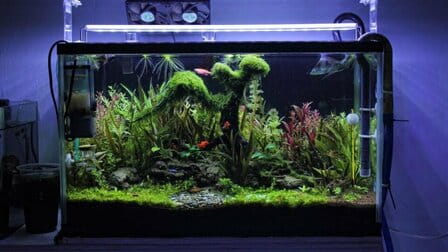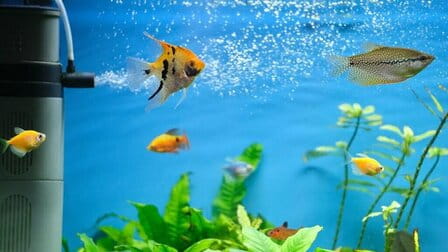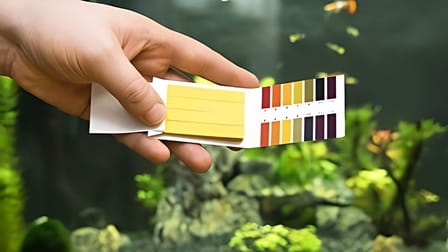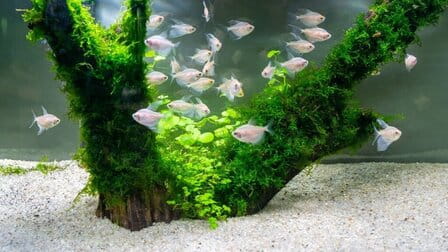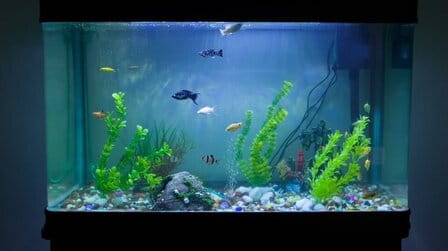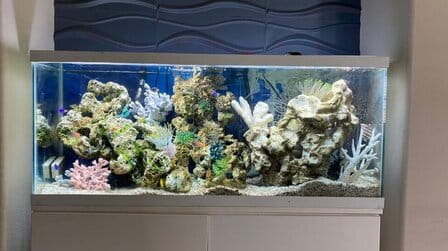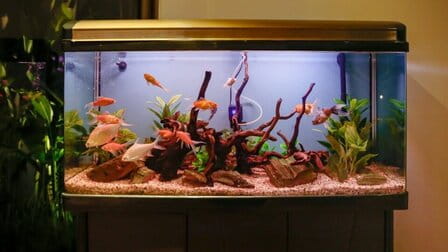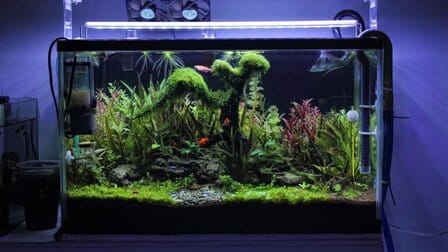Making your fish food at home doesn't have to be difficult. This not only balances the nutrients but also ensures that the additives are used safely.
While commercial food products contain many nutrients, they are too expensive and contain artificial ingredients as a means of preserving and improving flavor.
Below is a how-to-make fish food recipe and recipe. Thereby you will understand the delicious recipes that you can give to the fish.
1. Fish Diet
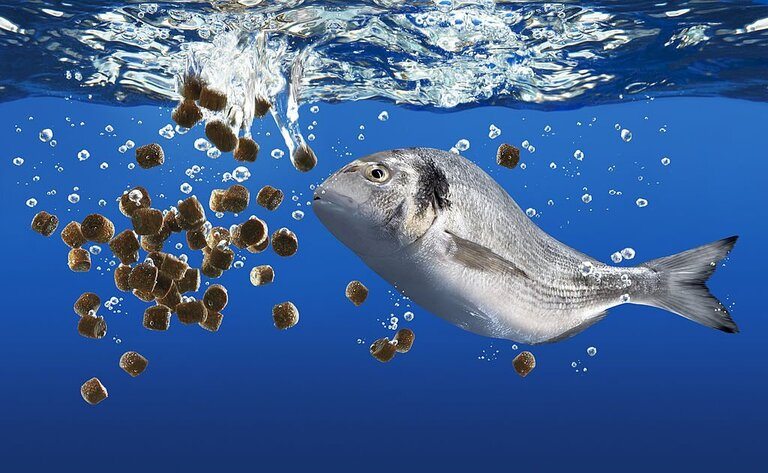
Fish will be no different from land animals when it comes to diet. Some will be herbivores, many will be omnivores, and a few will be carnivores. To avoid confusion, you can make your food, but you need to understand what kind of food they are, and what tools are needed to make food.
- Herbivores: there are many species of aquarium algae (otocinclus and plecostomus), some tropical species, and African cichlids, which are herbivores. Although these fish can eat protein from meat, most of their diet consists of plants.
- Omnivores: mostly aquarium fish for sale that will be listed as having an omnivorous diet. These fish will readily take both animals and plants and should be fed both regularly for good health. Omnivores tend to consume more plants, so animal protein is usually limited to about 20–40% of the diet.
- Carnivores: there are very few aquarium fish that are labeled as carnivores, tending to eat plants in the wild. So, for vitality and longevity in the aquarium, these fish are usually fed 60–70% animal matter and 30–40% vegetable matter.
2. Organic ingredients to make fish food
Ingredients

Gem Romaine Small Lettuce
It's dark leafy greens like Spinach, Romaine Lettuce, Kale, Sushi Seaweed, and Chard that provide a rich and nutritious plant source for any diet. It's also packed full of vitamins and minerals, these blues mimic the natural aquatic flora consumed by fish.
Garlic
Not only is it able to stimulate the appetite of most dirty fish, but it also maintains fish health by providing anti-bacterial properties.
Other fruits/vegetables
In addition to the fresh green leaves, a few additional fruits/vegetables should be added to the fish's food. This ensures that nutrition is obtained from many sources rather than just a few. The variety of nutrients will help the fish look and feel good. Broccoli, zucchini, carrots, apples, pears, peas, and oranges are all great additions to homemade fish food.
Spirulina Powder
Although these are just food additives, they are made up of cyanobacteria, spirulina powder is rich in minerals, vitamins, and amino acids. Natural pigments also help captive fish show beautiful colors.
Potato or corn starch
Use in an amount equal to a tablespoon or so will be added to the mix for bonding purposes. The starch holds the mixture together to create flakes when dried.
3. Some simple omnivore recipes

This homemade fish food recipe provides nutritious and flakes food for tropical aquatic inhabitants.
Element:
- 1 lb spinach
- 1/2 lb broccoli
- 2 cloves of garlic
- 1 zucchini
- Tough intestines from a winter squash
- 1/2 lb sunfish filet (skinless)
- 4 earthworms
- 1 Tbsp cornstarch
You can then manually create the shapes you want.
4. Protein ingredients to make fish food

Earthworms
Earthworms are an excellent and fairly inexpensive source of protein for fish food. If you don't want to mix live worms, just wash them and put them in the freezer first.
Other animals
Brine shrimp, bloodworms (mosquito larvae), and other bulk frozen foods provide a variety of fish food. Buy only from reputable sources to reduce contaminants and pathogens.
5. Process of making food for fish

Prepare your ingredients
Green vegetables should be washed and tougher vegetables (like broccoli, carrots, etc.) boiled. Many frozen ingredients should be defrosted. Fish should be descaled with bones.
Blending
You put all the ingredients in a blender or food processor and blend until the mixture reaches a smooth consistency.
Filter the mixture
Use a spatula to press the mixture through a medium fine mesh. This process is laborious but will remove pieces of bone/vegetables that are too large for fish consumption.
Drying
Allow three to four hours to dry the fish food into flakes. The process begins by coating large baking trays with wax or parchment. Usually, the paper will prevent dry food from sticking to the pan. Next, pour the refined mixture onto the paper sheets and spread them in a very thin layer (1/8–1/4"). Continue to place in the oven at 150°F and let dry for 3- 4 hours, or until mixture is completely crumbly.
Breaking
The plates will flake off in large patches. You use your hands to break them until you reach the desired size. Store in a dry place and cool environment. In an airtight container, the fish food will stay good for more than a year.
6. Some ways to prepare yourself from plants and animals
DIY fish food

The preparation of fish food is no different from food for terrestrial animals.
Fish are omnivores but some are carnivores and herbivores. Usually, to make the right food for aquarium fish, you should first learn about the dietary needs of the fish.
Homemade meat food
Meat-based foods are recommended for omnivores, carnivores and fish. It can feed small ornamental fish. Fish has many minerals, proteins, and essential oils that are good for growth.
Worms are a great addition to homemade dishes. You can find garden worms or buy them from online stores.
Usually, live worms are sold in stores as they do not have any additives. Each worm has a lot of nutrients and protein needed to fish.
Or you can feed them shrimp and snails as an additive to homemade food. Some other meat options for fish include beef hearts, squid, mussels, scallops, mussels, and mosquito larvae.
Plant-based homemade foods
Some plant-based foods are recommended for fish that are herbivores and omnivores. Green leafy plants are very good for fish because they contain many vitamins and minerals.
Limnophila, Egeria, and Cabomba are aquarium plants and can be purchased at most pet stores.
Fruits and vegetables
Fruits and vegetables are a great choice for fish. These are rich in diverse nutrients.
Dark green leafy vegetables contain many minerals and vitamins.
Fish loves kale, spinach, romaine, lettuce, and Seawood. Chad also contains a lot of nutrients for fish.
Or antibacterial garlic will keep your fish healthy and happy. You should crush or mince the garlic and then apply the mixture to the food. The spices stimulate the appetite of even picky eaters.
Spirulina powder is an additive that contains a lot of vitamins and minerals. It contains amino acids, cyanobacteria, and natural pigments that help fish maintain vibrant colors.
Corn or potato starch is recommended in food. One tablespoon is enough to add to solids and other foods.
How to preserve homemade fish food

Usually homemade fish food will be stored in ice trays. Frozen food can be transferred to an airtight container and used as needed.
Good things of making fish food at home
If making food at home you can make your own fish food at home, saving a lot of money. Most of the food we normally throw away can be eaten by fish - use it to feed our fish.
Home cooks give you the freedom to buy the best ingredients for your fish and control the amount of nutrients to include in their diet and even cater to their needs.
Conclusion
Often homemade food is healthier than store-bought food. This way you can prepare food that meets the exact dietary requirements of the fish.
Through the how to make fish food topic that to help you save money and measure the quality and food that your fish use.

